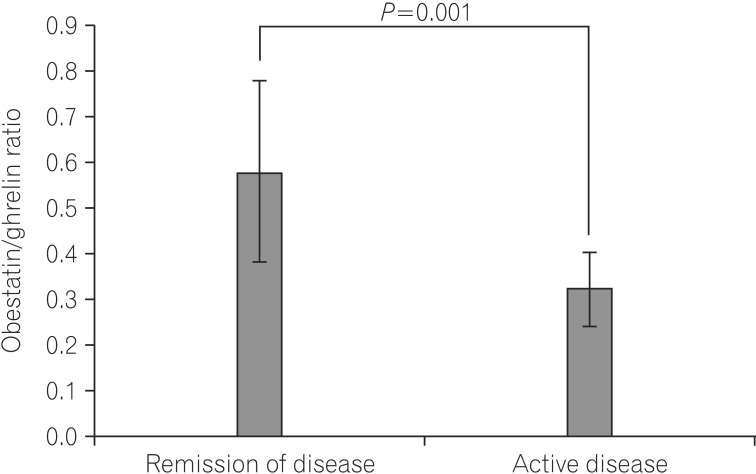Intest Res.
2015 Jan;13(1):68-73. 10.5217/ir.2015.13.1.68.
Circulating Ghrelin Levels and Obestatin/Ghrelin Ratio as a Marker of Activity in Ulcerative Colitis
- Affiliations
-
- 1Department of Internal Medicine, Seoul National University College of Medicine, Seoul National University Boramae Hospital, Seoul, Korea. jibjeong@snu.ac.kr
- KMID: 1807378
- DOI: http://doi.org/10.5217/ir.2015.13.1.68
Abstract
- BACKGROUND/AIMS
Ghrelin levels are known to increase in patients with ulcerative colitis (UC), but serum obestatin levels in UC patients are not well elucidated. The aim of this study was to examine the relationship between serum ghrelin and obestatin levels and disease activity in UC patients.
METHODS
The serum ghrelin and obestatin levels were measured in 21 UC patients (12 with active disease and 9 in remission) using enzyme-linked immunosorbent assay. The relationship between the circulating levels of these 2 hormones and disease activity was analyzed. The colonic mucosal mRNA expression of ghrelin and obestatin was measured by quantitative reverse transcription polymerase chain reaction.
RESULTS
The mean serum ghrelin values were significantly higher in patients with active disease than in patients with remission (1370.6+/-404.3 vs. 783.5+/-235.3 pg/mL, P=0.001). Colonic mucosal mRNA expression of ghrelin was also significantly higher in patients with active disease than in patients in remission (0.805+/-0.214 vs. 0.481+/-0.356, P=0.018). However, the mean serum obestatin levels and colonic mucosal mRNA expression of obestatin were not significantly different between both groups. The circulating obestatin/ghrelin ratio was significantly lower in patients with active UC than in patients in remission (0.32+/-0.08 vs. 0.58+/-0.20, P=0.001).
CONCLUSIONS
The serum ghrelin levels and the obestatin/ghrelin ratio were related to the activity of UC, but serum obestatin was not related to activity of UC. The ghrelin levels and the obestatin/ghrelin ratio could serve as activity markers in patients with UC.
Keyword
MeSH Terms
Figure
Reference
-
1. Goh J, O'Morain CA. Review article: nutrition and adult inflammatory bowel disease. Aliment Pharmacol Ther. 2003; 17:307–320. PMID: 12562443.2. Bamias G, Nyce MR, De La, Cominelli F. New concepts in the pathophysiology of inflammatory bowel disease. Ann Intern Med. 2005; 143:895–904. PMID: 16365470.3. Karmiris K, Koutroubakis IE, Xidakis C, Polychronaki M, Voudouri T, Kouroumalis EA. Circulating levels of leptin, adiponectin, resistin, and ghrelin in inflammatory bowel disease. Inflamm Bowel Dis. 2006; 12:100–105. PMID: 16432373.4. Deboer MD. Use of ghrelin as a treatment for inflammatory bowel disease: mechanistic considerations. Int J Pept. doi:10.1155/2011/189242. Published online 9 August 2011.5. DeBoer MD. Emergence of ghrelin as a treatment for cachexia syndromes. Nutrition. 2008; 24:806–814. PMID: 18725076.6. Nakazato M, Murakami N, Date Y, et al. A role for ghrelin in the central regulation of feeding. Nature. 2001; 409:194–198. PMID: 11196643.
Article7. Tschop M, Smiley DL, Heiman ML. Ghrelin induces adiposity in rodents. Nature. 2000; 407:908–913. PMID: 11057670.8. Dixit VD, Schaffer EM, Pyle RS, et al. Ghrelin inhibits leptin- and activation-induced proinflammatory cytokine expression by human monocytes and T cells. J Clin Invest. 2004; 114:57–66. PMID: 15232612.
Article9. Granado M, Priego T, Martin AI, Villanua MA, Lopez-Calderon A. Anti-inflammatory effect of the ghrelin agonist growth hormone-releasing peptide-2 (GHRP-2) in arthritic rats. Am J Physiol Endocrinol Metab. 2005; 288:E486–E492. PMID: 15507538.10. Capristo E, Farnetti S, Mingrone G, et al. Reduced plasma ghrelin concentration in celiac disease after gluten-free diet treatment. Scand J Gastroenterol. 2005; 40:430–436. PMID: 16028437.
Article11. Suzuki H, Masaoka T, Hosoda H, et al. Helicobacter pylori infection modifies gastric and plasma ghrelin dynamics in Mongolian gerbils. Gut. 2004; 53:187–194. PMID: 14724148.12. Peracchi M, Conte D, Terrani C, et al. Circulating ghrelin levels in celiac patients. Am J Gastroenterol. 2003; 98:2474–2478. PMID: 14638351.13. Lanzini A, Magni P, Petroni ML, et al. Circulating ghrelin level is increased in coeliac disease as in functional dyspepsia and reverts to normal during gluten-free diet. Aliment Pharmacol Ther. 2006; 23:907–913. PMID: 16573793.14. Zhang JV, Ren PG, Avsian-Kretchmer O, et al. Obestatin, a peptide encoded by the ghrelin gene, opposes ghrelin's effects on food intake. Science. 2005; 310:996–999. PMID: 16284174.
Article15. Alexandridis E, Zisimopoulos A, Liratzopoulos N, Katsos I, Manolas K, Kouklakis G. Obestatin/ghrelin ratio: a new activity index in inflammatory bowel diseases. Inflamm Bowel Dis. 2009; 15:1557–1561. PMID: 19408254.16. Travis SP, Higgins PD, Orchard T, et al. Review article: defining remission in ulcerative colitis. Aliment Pharmacol Ther. 2011; 34:113–124. PMID: 21615435.
Article17. Seo HI, Park DI, Kim TO, et al. The effect of infliximab on patients with ulcerative colitis in Korea. Intest Res. 2014; 12:214–220. PMID: 25349595.
Article18. Hwangbo Y, Kim HJ, Shim JJ, et al. Change of circulating leptin, adiponectin, resistin, and visfatin level after treatment of patients with active inflammatory bowel disease. Intest Res. 2010; 8:151–161.
Article19. Hosomi S, Oshitani N, Kamata N, et al. Phenotypical and functional study of ghrelin and its receptor in the pathogenesis of Crohn's disease. Inflamm Bowel Dis. 2008; 14:1205–1213. PMID: 18425803.20. Karmiris K, Koutroubakis IE. Resistin: another rising biomarker in inflammatory bowel disease? Eur J Gastroenterol Hepatol. 2007; 19:1035–1037. PMID: 17998823.
Article21. Tilg H, Moschen AR. Adipocytokines: mediators linking adipose tissue, inflammation and immunity. Nat Rev Immunol. 2006; 6:772–783. PMID: 16998510.
Article22. Karmiris K, Koutroubakis IE, Kouroumalis EA. Leptin, adiponectin, resistin, and ghrelin--implications for inflammatory bowel disease. Mol Nutr Food Res. 2008; 52:855–866. PMID: 18383234.
Article23. Gonzalez-Rey E, Chorny A, Delgado M. Therapeutic action of ghrelin in a mouse model of colitis. Gastroenterology. 2006; 130:1707–1720. PMID: 16697735.
Article




